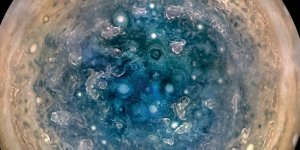| News / Space News |
Possible New Moon Forming Around Saturn
NASA | APRIL 21, 2014
NASA's Cassini spacecraft has documented the formation of a small icy object within the rings of Saturn. Informally named "Peggy," the object may be a new moon.

Disturbance at the outer edge of Saturn's A ring. Image credit: NASA/JPL-Caltech/Space Science Institute
Images taken with Cassini's narrow angle camera on April 15, 2013 show disturbances at the very edge of Saturn's A ring -- the outermost of the planet's large, bright rings. One of these disturbances is an arc about 20 percent brighter than its surroundings, 750 miles (1,200 kilometers) long and 6 miles (10 kilometers) wide.
Scientists also found unusual protuberances in the usually smooth profile at the ring's edge. Scientists believe the arc and protuberances are caused by the gravitational effects of a nearby object.
The object is not expected to grow any larger, and may even be falling apart. But the process of its formation and outward movement aids in our understanding of how Saturn's icy moons, including the cloud-wrapped Titan and ocean-holding Enceladus, may have formed in more massive rings long ago. It also provides insight into how Earth and other planets in our solar system may have formed and migrated away from our star, the sun.
Cassini's orbit will move closer to the outer edge of the A ring in late 2016 and provide an opportunity to study Peggy in more detail and perhaps even image it.
Peggy is too small to see in images so far. Scientists estimate it is probably no more than about a half mile in diameter. Saturn's icy moons range in size depending on their proximity to the planet -- the farther from the planet, the larger. And many of Saturn's moons are comprised primarily of ice, as are the particles that form Saturn's rings.
Based on these facts, and other indicators, researchers recently proposed that the icy moons formed from ring particles and then moved outward, away from the planet, merging with other moons on the way.
It is possible the process of moon formation in Saturn's rings has ended with Peggy, as Saturn's rings now are, in all likelihood, too depleted to make more moons.
YOU MAY ALSO LIKE




